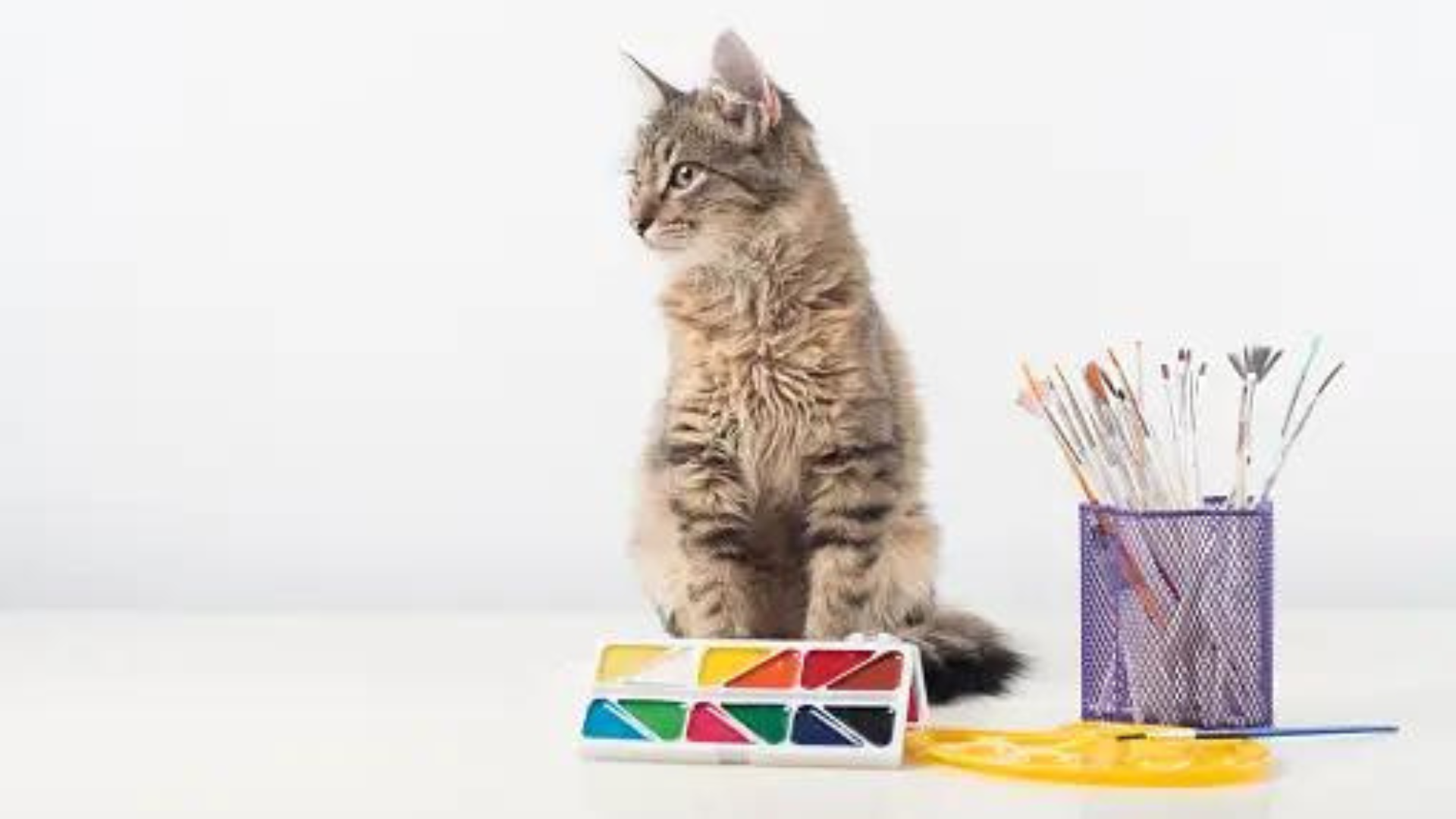I’ve been painting with acrylics for years and have fallen in love with how vibrant and versatile they can be.
But ever since adopting my cat Luna, I’ve started to wonder whether those colorful paints I use so often could pose a health risk to pets. I
f you also use acrylic paint at home and have a feline friend, you may be curious too – is acrylic paint toxic to cats?
While acrylics are considered less hazardous than oil paints, they do contain chemicals that could cause issues if ingested.
Let’s take a closer look at acrylic paint’s ingredients and potential toxicity to cats.
Potential Toxins Lurking in Acrylics
While less dangerous than oils, acrylic paint isn’t completely harmless either. Acrylic paint is composed of color pigments suspended in an acrylic polymer emulsion. Even though water-based, this emulsion contains traces of materials like:
- Ammonia – Added to help stabilize and apply the paint
- Formaldehyde – Used in manufacturing to link polymer chains
- Methanol – A solvent added to enhance drying time
These compounds could potentially irritate eyes, skin, and lungs if vapors are inhaled, especially during extensive exposure. That new paint smell when first opened is actually trace ammonia and formaldehyde evaporating. Always paint in well-ventilated areas.
In addition, some pigments used to create certain colors may contain heavy metals like cadmium, chromium, cobalt, lead, or zinc. These metals can have toxic effects if absorbed into the body in high concentrations. Lead in particular poses health risks if ingested.
Now you can understand why acrylic paint might not be completely safe if swallowed, especially by pets. Let’s look at the specific risks it could pose to cats.
Health Risks to Cats from Ingesting Paint
For humans, incidental exposure to acrylic paint is not severely hazardous. But for smaller animals like cats, ingesting paint could be dangerous depending on the amount.
If a cat licked or swallowed wet or dry acrylic paint, they could experience:
- Nausea, vomiting, drooling, diarrhea
- Loss of appetite
- Abdominal pain
Consuming larger quantities could even potentially damage their liver or kidneys over time due to heavy metal and chemical absorption.
While a small nibble may only cause minor stomach upset, it’s best to keep cats away from acrylic paint. Chronic exposure could lead to poisoning depending on the paint’s ingredients. Let’s go over some tips for safe use.
Storing and Using Paints Cautiously
Okay, I don’t want to scare you into ditching your acrylics! With care, you can still use acrylic paint without endangering your pet. Here are some best practices:
- Always keep paints sealed tight and stored up high when not in use. Never leave open containers unattended.
- Paint in rooms your cat can’t access or close doors to keep them safely away from workspaces.
- Avoid painting surfaces your cat could easily ingest paint from if scratched.
- Let painted items fully dry before allowing your cat near them. Consider using pet-safe sealers.
- Thoroughly wash any paint spills right away with soap and water. Properly dispose of all paint-covered rags.
With caution, it’s certainly possible to continue safely using acrylics in households with cats. But we need to take care to mitigate any potential risks. Next, let’s go over some alternative options.
Safer Paint Choices for Pets
If you want guaranteed pet-safe paints, some brands formulate their acrylics to be non-toxic when dry:
- Sargent Art – Their kids’ acrylic paint line is AP Certified non-toxic.
- U.S. Art Supply – All acrylics certified by ACMI to be safe for kids.
You could also explore kid-friendly tempera or fingerpaints. Just check that they are labeled non-toxic when dry.
For home projects, look for zero-VOC acrylic paints from brands like Benjamin Moore. VOCs (volatile organic compounds) are off-gassed as paint dries and can irritate lungs if inhaled.
Keeping Your Cat Stimulated and Safe
Rather than worrying about your cat getting into arts and crafts, try engaging their mind!
Place a cat tree or perch near your workspace so they can watch your creative process safely. Break out the catnip or feather wand before you start painting to prevent boredom or mischief.
You can even do supervised “paw print” art by letting your cat walk on canvas on the floor. Protect both your cat’s health and your creative outlet with planning and precaution.
While acrylic paint isn’t highly toxic, it does require awareness when living with curious pets prone to nibbling. But with care, you can still enjoy acrylic painting without endangering your feline friend.
Potential Health Risks of Acrylic Paint to Cats
Now that we’ve covered the basics of acrylic paint, let’s dig into the key question: could acrylic paint be toxic to your cat? Unfortunately, acrylic paint does carry some risks, especially if ingested by our feline friends.
The primary ingredients in acrylic paint are pigments suspended in an acrylic polymer emulsion. Even though water-based, these polymer emulsions can contain traces of materials like ammonia, formaldehyde, or methanol. The pigments themselves may also have heavy metals like cadmium or cobalt.
If your cat somehow ingested wet or dry acrylic paint, the paint could upset their digestive system, leading to vomiting, diarrhea, or loss of appetite. The heavy metals could also be toxic to your cat’s kidneys and liver if they absorbed enough.
For most cats, a small lick or bite of acrylic paint may only cause minor stomach irritation. But ingesting larger amounts could have more severe effects, so it’s best to keep cats away from acrylics.
Watch Out for Allergic Reactions
Some cats may also have skin reactions if they get acrylic paint on their fur or paws. The acrylic polymer emulsion could trigger allergic dermatitis in sensitive cats. You’re more likely to see irritation around areas with thinner fur, like the ears, paws, belly, or tail.
If your cat’s skin becomes red, itchy, or scabbed after contact with acrylic paint, take them to the vet. They can provide medication to relieve the allergic reaction and help heal any afflicted areas on the skin.
To be safe, it’s best to keep wet and dry acrylic paint off your cat’s coat. Dried acrylic paint could even harden to a plastic-like film on the fur. This could cause discomfort when grooming.
Storing and Using Paints Safely
Okay, I don’t mean to scare you into putting away your paintbrushes for good! With proper precautions, you can still use acrylic paint without endangering your curious cat. Here are some tips:
- When not in use, make sure all paints and thinners are sealed tightly and stored up high or in closed cabinets. Never leave open containers unattended.
- Paint in areas your cat can’t access, such as a spare room. Close doors to keep your cat safely away from workspaces.
- Avoid painting on surfaces your cat could scratch up and ingest, like bare wood trim or furniture.
- Let painted items fully dry before allowing your cat near them. Use pet-safe sealers on paint when dry.
- Clean up spills right away with soap and water. Dispose of rags so your cat won’t nibble on them.
Kid-Safe Paint Alternatives
If you need peace of mind, consider switching to acrylic paint brands formulated to be non-toxic. Some options:
- Sargent Art – Makes a kids’ acrylic paint line that is AP Certified non-toxic when dry.
- U.S. Art Supply – Their acrylic paints are certified by the Art & Creative Materials Institute as safe for all ages.
You could also explore kid-friendly paint mediums like tempera or fingerpaints. Just check labels to ensure they are non-toxic when dry.
Fun Distractions for Your Cat
Rather than worrying about your cat around paints, maybe redirect their energy? Set up a cat tower or perch near your workspace so they can observe your creative process safely.
Break out the catnip or pull out the feather wand for playtime before you start painting. Get those zooms out so your cat is less likely to pester you and your art supplies.
Consider doing a Jackson Pollock-style piece – lay a canvas on the floor and let your cat walk on it to create abstract paw print art! Supervised of course.
To Paint or Not to Paint?
In the end, acrylic paint does require some safety awareness when you have a cat at home. But with proper care and common sense, you can still enjoy painting without putting your furry buddy at risk. Just be cautious in how you use and store your acrylics.
I hope these tips help you maintain both your creative outlet and your cat’s good health. Our pets’ wellbeing should always come first, even if it means changing some habits. But often simple adjustments are all you need to remove hazards from your home.
So don’t retire your paintbrushes yet! Just be smart about materials and give your cat plenty of toys and attention. With a few precautions, you can keep on creating while also keeping your cat out of harm’s way. Both your art and your pet will thank you.
FAQs
What paints are toxic to cats?
Oil-based paints are more toxic to cats than water-based paints. Specifically, ingesting oil paint can cause severe poisoning in cats. Acrylic paints are water-based and less toxic, but they can still potentially cause illness in cats if large amounts are consumed.
Will paint hurt a cat?
Yes, ingesting paint may hurt or even poison a cat in some cases. Oil paint is more likely to cause toxicity, but acrylic paint can also irritate a cat’s digestive system and cause symptoms like vomiting or diarrhea if swallowed. Even small amounts licked when grooming paws or fur can cause adverse reactions.
Can I paint with my cat in the room?
It’s best not to paint with acrylics or oils in the same room as your cat. Keep cats separate from paint supplies and work areas when possible to prevent accidental ingestion or paw prints in paint. If you must paint with a cat nearby, use pet-safe paints and seal finished artwork.
Is acrylic paint toxic to cats aspca?
The ASPCA does warn that acrylic paint, if ingested, can potentially cause stomach upset, depression, or chemical pneumonia. They note that acrylics are likely less toxic than oil paints but still advise keeping all paints safely out of pets’ reach. Storing paints securely closed and high up is recommended by the ASPCA for households with cats.

